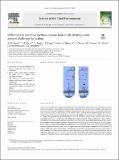| dc.contributor.author | Baron, A .A. P. | |
| dc.contributor.author | Dyck, L. T. | |
| dc.contributor.author | Amjad, H. | |
| dc.contributor.author | Bragg, J. | |
| dc.contributor.author | Kroft, E. | |
| dc.contributor.author | Newson, J. | |
| dc.contributor.author | Oleson, K. | |
| dc.contributor.author | Casson, N. J. | |
| dc.contributor.author | North, R. L. | |
| dc.contributor.author | Venkiteswaran, J. J. | |
| dc.contributor.author | Whitfield., C. J. | |
| dc.date.accessioned | 2023-09-19T18:16:17Z | |
| dc.date.available | 2023-09-19T18:16:17Z | |
| dc.date.issued | 2022 | |
| dc.identifier.citation | Baron, A. A. P., L. T. Dyck, H. Amjad, J. Bragg, E. Kroft, J. Newson, K. Oleson, N. J. Casson, R. L. North, J. J. Venkiteswaran, and C. J. Whitfield. "Differences in ebullitive methane release from small, shallow ponds present challenges for scaling." Science of the Total Environment 802 (2022): article no. 149685. DOI: 10.1016/j.scitotenv.2021.149685. | en_US |
| dc.identifier.issn | 0048-9697 | |
| dc.identifier.uri | https://hdl.handle.net/10680/2112 | |
| dc.description.abstract | Small, shallow waterbodies are potentially important sites of greenhouse gas release to the atmosphere. The role of ebullition may be enhanced here relative to larger and deeper systems, due to their shallow water, but these features remain relatively infrequently studied in comparison to larger systems.Herein,we quantify ebullitive release ofmethane (CH4) in small shallow ponds in three regions of North America and investigate the role of potential drivers. Shallow ponds exhibited open-water season ebullitive CH4 release rates as high as 40 mmol m–2 d–1, higher than previously reported for similar systems. Ebullitive release of CH4 varied by four orders of magnitude across our 15 study sites, with differences in flux rates both within and between regions. What is less clear are the drivers responsible for these differences. There were few relationships between open water–season ebullitive flux and physicochemical characteristics, including organic matter, temperature, and sulphate. Temperature was only weakly related to ebullitive CH4 release across the studywhen considering all observation intervals. Only four individual sites exhibited significant relationships between temperature and ebullitive CH4 release. Other sites were unresponsive to temperature, and region-specific factors may play a role. There is some evidence that where surface water sulphate concentrations are high, CH4 production and release may be suppressed. Missouri sites (n = 5) had characteristically low ebullitive CH4 release; here bioturbation could be important. While this work greatly expands the number of open-water season ebullition rates for small and shallow ponds, more research is needed to disentangle the role of different drivers. Further investigation of the potential thresholding behaviour of sulphate as a control on ebullitive CH4 release in lentic systems is one such opportunity. What is clear, however, is that efforts to scale emissions (e.g., as a function of temperature) must be undertaken with caution. | en_US |
| dc.description.sponsorship | "Fieldwork at US and GHG analyses for the project were funded through an NSERC-DG awarded to CJW. Fieldwork and analysis at UW were funded through an NSERC-DG awarded to NJC. Fieldwork and nutrient analysis atMUwere funded by the Prairie Fork Charitable Endowment Trust to RLN." | en_US |
| dc.description.uri | https://www.sciencedirect.com/science/article/pii/S0048969721047604 | en_US |
| dc.language.iso | en | en_US |
| dc.publisher | Elsevier B.V. | en_US |
| dc.rights | info:eu-repo/semantics/openAccess | en_US |
| dc.title | Differences in ebullitive methane release from small, shallow ponds present challenges for scaling | en_US |
| dc.type | Article | en_US |
| dc.rights.license | This is an open access article under the CC BY-NC-ND license (http://creativecommons.org/licenses/by-nc-nd/4.0/). | en_US |
| dc.identifier.doi | 10.1016/j.scitotenv.2021.149685 | en_US |

